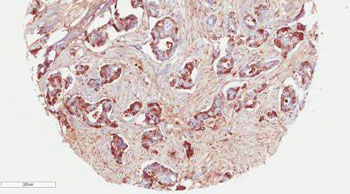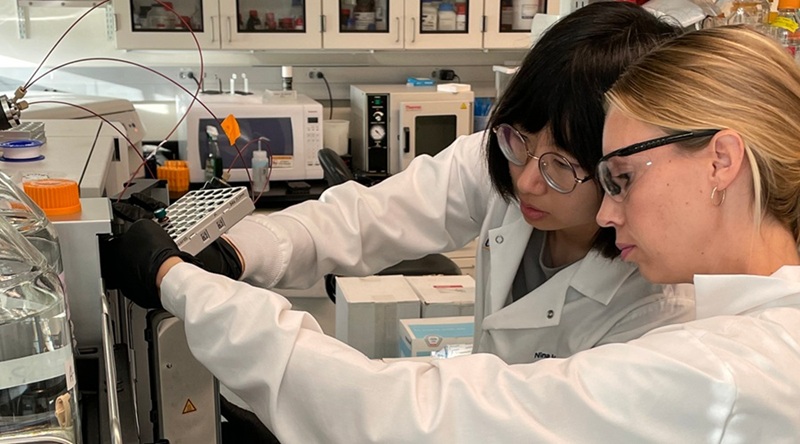Growth and Spread of Breast Cancer Linked to Tumor Cells' Expression of a Cartilage Protein
|
By LabMedica International staff writers Posted on 27 Apr 2016 |

Image: High expression of COMP in breast cancer cells, seen here in brown, was associated with poor clinical prognosis for the patient. Cancer cells expressing COMP became more invasive and changed their metabolism, which allowed them to survive better and spread to other organs (Photo courtesy of Dr. Anna Blom, Lund University).
A team of Swedish cancer researchers has identified a protein in breast tumors and surrounding stromal tissue that contributes to the development and spread of the disease.
Investigators at Lund University (Malmö, Sweden) using tissue microarrays derived from two cohorts of patients with breast cancer found that the protein COMP (cartilage oligomeric matrix protein), a soluble pentameric protein expressed in cartilage and involved in collagen organization, was expressed to a varying degree in the tumor cells and surrounding stroma. High levels of COMP in tumor cells correlated, independently of other variables, with poor survival and decreased recurrence-free survival. Normal breast tissue did not express detectable levels of COMP.
The investigators injected MDA-MB-231breast cancer cells that stably expressed COMP into the mammary fat pads of SCID (CB-17/Icr-Prkdcscid/Rj) mice. They reported in the April 11, 2016, online edition of the journal Oncogene that tumors expressing COMP were significantly larger and were more prone to metastasize as compared with control tumors that did not express the protein.
In vitro experiments confirmed that COMP-expressing cells had a more invasive phenotype, which could in part be attributed to an upregulation of the enzyme matrix metalloprotease-9. Microarray analyses of gene expression in tumors formed in vivo showed that COMP expression induced higher expression of genes protecting against endoplasmic reticulum stress. Furthermore, in vitro measurement of cell respiration indicated that COMP-expressing cells appeared to undergo a metabolic switch, that is, a Warburg effect, in which they produced energy by a high rate of glycolysis followed by lactic acid fermentation in the cytosol, rather than by a comparatively low rate of glycolysis followed by oxidation of pyruvate in mitochondria as in most normal cells.
Based on these results, the investigators concluded that COMP was a novel biomarker in breast cancer, which contributed to the severity of the disease by metabolic switching and increasing invasiveness and tumor cell viability, leading to reduced survival in animal models and human patients.
"We saw a clear association between high levels of COMP and a worse breast cancer prognosis. With more research, COMP has the potential of becoming an indicator of aggressive breast cancer, and thereby providing early and valuable information before deciding on an appropriate treatment," said senior author Dr. Anna Blom, professor of protein chemistry at Lund University.
Related Links:
Lund University
Investigators at Lund University (Malmö, Sweden) using tissue microarrays derived from two cohorts of patients with breast cancer found that the protein COMP (cartilage oligomeric matrix protein), a soluble pentameric protein expressed in cartilage and involved in collagen organization, was expressed to a varying degree in the tumor cells and surrounding stroma. High levels of COMP in tumor cells correlated, independently of other variables, with poor survival and decreased recurrence-free survival. Normal breast tissue did not express detectable levels of COMP.
The investigators injected MDA-MB-231breast cancer cells that stably expressed COMP into the mammary fat pads of SCID (CB-17/Icr-Prkdcscid/Rj) mice. They reported in the April 11, 2016, online edition of the journal Oncogene that tumors expressing COMP were significantly larger and were more prone to metastasize as compared with control tumors that did not express the protein.
In vitro experiments confirmed that COMP-expressing cells had a more invasive phenotype, which could in part be attributed to an upregulation of the enzyme matrix metalloprotease-9. Microarray analyses of gene expression in tumors formed in vivo showed that COMP expression induced higher expression of genes protecting against endoplasmic reticulum stress. Furthermore, in vitro measurement of cell respiration indicated that COMP-expressing cells appeared to undergo a metabolic switch, that is, a Warburg effect, in which they produced energy by a high rate of glycolysis followed by lactic acid fermentation in the cytosol, rather than by a comparatively low rate of glycolysis followed by oxidation of pyruvate in mitochondria as in most normal cells.
Based on these results, the investigators concluded that COMP was a novel biomarker in breast cancer, which contributed to the severity of the disease by metabolic switching and increasing invasiveness and tumor cell viability, leading to reduced survival in animal models and human patients.
"We saw a clear association between high levels of COMP and a worse breast cancer prognosis. With more research, COMP has the potential of becoming an indicator of aggressive breast cancer, and thereby providing early and valuable information before deciding on an appropriate treatment," said senior author Dr. Anna Blom, professor of protein chemistry at Lund University.
Related Links:
Lund University
Latest BioResearch News
- Genome Analysis Predicts Likelihood of Neurodisability in Oxygen-Deprived Newborns
- Gene Panel Predicts Disease Progession for Patients with B-cell Lymphoma
- New Method Simplifies Preparation of Tumor Genomic DNA Libraries
- New Tool Developed for Diagnosis of Chronic HBV Infection
- Panel of Genetic Loci Accurately Predicts Risk of Developing Gout
- Disrupted TGFB Signaling Linked to Increased Cancer-Related Bacteria
- Gene Fusion Protein Proposed as Prostate Cancer Biomarker
- NIV Test to Diagnose and Monitor Vascular Complications in Diabetes
- Semen Exosome MicroRNA Proves Biomarker for Prostate Cancer
- Genetic Loci Link Plasma Lipid Levels to CVD Risk
- Newly Identified Gene Network Aids in Early Diagnosis of Autism Spectrum Disorder
- Link Confirmed between Living in Poverty and Developing Diseases
- Genomic Study Identifies Kidney Disease Loci in Type I Diabetes Patients
- Liquid Biopsy More Effective for Analyzing Tumor Drug Resistance Mutations
- New Liquid Biopsy Assay Reveals Host-Pathogen Interactions
- Method Developed for Enriching Trophoblast Population in Samples
Channels
Clinical Chemistry
view channel
Online Tool Detects Drug Exposure Directly from Patient Samples
Doctors often rely on patient interviews and medical records to determine what medications a person has taken, but this information is frequently incomplete. People may forget drugs they used, take over-the-counter... Read more
Chemical Imaging Probe Could Track and Treat Prostate Cancer
Prostate cancer remains a leading cause of illness and death among men, with many patients eventually developing resistance to standard hormone-blocking therapies. These drugs often lose effectiveness... Read moreMolecular Diagnostics
view channel
New 15-Minute Hepatitis C Test Paves Way for Same-Day Treatment
Chronic hepatitis C infection affects an estimated 50 million people worldwide and causes around 242,000 deaths each year, largely due to cirrhosis and liver cancer. Although the infection is curable with... Read more
Ovarian Cancer Assay Outperforms Traditional Tests in Early Disease Detection
Globally, ovarian cancer is one of the deadliest cancers affecting women. Traditionally, early diagnosis of ovarian cancer has been challenging. Many ovarian cancers are diagnosed only after they have... Read moreHematology
view channel
MRD Tests Could Predict Survival in Leukemia Patients
Acute myeloid leukemia is an aggressive blood cancer that disrupts normal blood cell production and often relapses even after intensive treatment. Clinicians currently lack early, reliable markers to predict... Read more
Platelet Activity Blood Test in Middle Age Could Identify Early Alzheimer’s Risk
Early detection of Alzheimer’s disease remains one of the biggest unmet needs in neurology, particularly because the biological changes underlying the disorder begin decades before memory symptoms appear.... Read more
Microvesicles Measurement Could Detect Vascular Injury in Sickle Cell Disease Patients
Assessing disease severity in sickle cell disease (SCD) remains challenging, especially when trying to predict hemolysis, vascular injury, and risk of complications such as vaso-occlusive crises.... Read more
ADLM’s New Coagulation Testing Guidance to Improve Care for Patients on Blood Thinners
Direct oral anticoagulants (DOACs) are one of the most common types of blood thinners. Patients take them to prevent a host of complications that could arise from blood clotting, including stroke, deep... Read moreImmunology
view channel
Routine Blood Test Can Predict Who Benefits Most from CAR T-Cell Therapy
CAR T-cell therapy has transformed treatment for patients with relapsed or treatment-resistant non-Hodgkin lymphoma, but many patients eventually relapse despite an initial response. Clinicians currently... Read more
New Test Distinguishes Vaccine-Induced False Positives from Active HIV Infection
Since HIV was identified in 1983, more than 91 million people have contracted the virus, and over 44 million have died from related causes. Today, nearly 40 million individuals worldwide live with HIV-1,... Read more
Gene Signature Test Predicts Response to Key Breast Cancer Treatment
DK4/6 inhibitors paired with hormone therapy have become a cornerstone treatment for advanced HR+/HER2– breast cancer, slowing tumor growth by blocking key proteins that drive cell division.... Read more
Chip Captures Cancer Cells from Blood to Help Select Right Breast Cancer Treatment
Ductal carcinoma in situ (DCIS) accounts for about a quarter of all breast cancer cases and generally carries a good prognosis. This non-invasive form of the disease may or may not become life-threatening.... Read moreMicrobiology
view channel
Blood-Based Diagnostic Method Could Identify Pediatric LRTIs
Lower-respiratory tract infections (LRTIs) are a leading cause of illness and death worldwide, and pneumonia is the leading infectious cause of death in children under five, claiming the lives of over... Read more
Rapid Diagnostic Test Matches Gold Standard for Sepsis Detection
Sepsis kills 11 million people worldwide every year and generates massive healthcare costs. In the USA and Europe alone, sepsis accounts for USD 100 billion in annual hospitalization expenses.... Read moreRapid POC Tuberculosis Test Provides Results Within 15 Minutes
Tuberculosis remains one of the world’s deadliest infectious diseases, and reducing new cases depends on identifying individuals with latent infection before it progresses. Current diagnostic tools often... Read more
Rapid Assay Identifies Bloodstream Infection Pathogens Directly from Patient Samples
Bloodstream infections in sepsis progress quickly and demand rapid, precise diagnosis. Current blood-culture methods often take one to five days to identify the pathogen, leaving clinicians to treat blindly... Read morePathology
view channel
Rapid Low-Cost Tests Can Prevent Child Deaths from Contaminated Medicinal Syrups
Medicinal syrups contaminated with toxic chemicals have caused the deaths of hundreds of children worldwide, exposing a critical gap in how these products are tested before reaching patients.... Read more
Tumor Signals in Saliva and Blood Enable Non-Invasive Monitoring of Head and Neck Cancer
Head and neck cancers are among the most aggressive malignancies worldwide, with nearly 900,000 new cases diagnosed each year. Monitoring these cancers for recurrence or relapse typically relies on tissue... Read more
Common Health Issues Can Influence New Blood Tests for Alzheimer’s Disease
Blood-based tests for Alzheimer’s disease are transforming diagnosis by offering a simpler alternative to spinal taps and brain imaging. However, many people evaluated at memory clinics also live with... Read more
Blood Test Formula Identifies Chronic Liver Disease Patients with Higher Cancer Risk
Chronic liver disease affects millions worldwide and can progress silently to hepatocellular carcinoma (HCC), one of the deadliest cancers globally. While surveillance guidelines exist for patients with... Read moreTechnology
view channel
Machine Learning Models Diagnose ALS Earlier Through Blood Biomarkers
Amyotrophic lateral sclerosis (ALS) is a rapidly progressive neurodegenerative disease that is notoriously difficult to diagnose in its early stages. Early symptoms often overlap with other neurological... Read more
Artificial Intelligence Model Could Accelerate Rare Disease Diagnosis
Identifying which genetic variants actually cause disease remains one of the biggest challenges in genomic medicine. Each person carries tens of thousands of DNA changes, yet only a few meaningfully alter... Read moreIndustry
view channel
Abbott Acquires Cancer-Screening Company Exact Sciences
Abbott (Abbott Park, IL, USA) has entered into a definitive agreement to acquire Exact Sciences (Madison, WI, USA), enabling it to enter and lead in fast-growing cancer diagnostics segments.... Read more



















